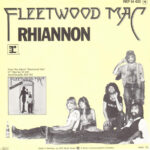 Fleetwood Mac’s “Rhiannon” stands as one of the defining tracks of the band’s illustrious career, a song that blends mystical storytelling, compelling musicality, and unforgettable vocals into a timeless classic. Featured on the 1975 self-titled album Fleetwood Mac, “Rhiannon” not only showcases the band’s evolution from blues roots into a more rock-pop oriented sound but also highlights Stevie Nicks’ emergence as a formidable songwriter and frontwoman. The song’s enduring popularity stems from its hypnotic blend of narrative lyricism, soaring melodies, and theatrical performance style, making it a touchstone of both 1970s rock and the broader cultural imagination.
Fleetwood Mac’s “Rhiannon” stands as one of the defining tracks of the band’s illustrious career, a song that blends mystical storytelling, compelling musicality, and unforgettable vocals into a timeless classic. Featured on the 1975 self-titled album Fleetwood Mac, “Rhiannon” not only showcases the band’s evolution from blues roots into a more rock-pop oriented sound but also highlights Stevie Nicks’ emergence as a formidable songwriter and frontwoman. The song’s enduring popularity stems from its hypnotic blend of narrative lyricism, soaring melodies, and theatrical performance style, making it a touchstone of both 1970s rock and the broader cultural imagination.
At its core, “Rhiannon” is a mystical meditation on power, desire, and freedom, drawing inspiration from Welsh mythology while remaining deeply personal in its emotional resonance. Nicks’ ethereal vocals, coupled with the intricate interplay of guitar, keyboards, and rhythm section, craft an immersive experience that transports the listener into a realm where myth and human longing intersect. Its success rests not only in the song’s musical composition but in its ability to evoke a sense of mystery, enchantment, and timelessness.
Origins and Context
Stevie Nicks, who joined Fleetwood Mac alongside Lindsey Buckingham in 1975, brought with her a wealth of songwriting ambition and mystical imagery cultivated during her years as part of the duo Buckingham Nicks. “Rhiannon” was inspired by the Welsh witch goddess of the same name, whose legends are imbued with themes of independence, magic, and transformative power. Nicks has described being fascinated with the story after reading Mary Bartlet Leader’s novel Triad, in which the character Rhiannon appears as a powerful, enigmatic figure. This fascination informed both the lyrical content and the theatricality with which Nicks performed the song.
The mid-1970s marked a pivotal moment for Fleetwood Mac. Transitioning from a primarily blues-oriented group into a more mainstream rock ensemble, the band was seeking to define a new sound that could resonate with the broader audience while retaining musical sophistication. “Rhiannon” exemplifies this synthesis: it retains the emotive depth and instrumental nuance of Fleetwood Mac’s earlier work while embracing the accessibility and drama that would come to define their mainstream appeal.
Musical Composition and Arrangement
“Rhiannon” is musically notable for its dynamic structure and distinctive arrangement. Opening with Mick Fleetwood’s precise, rolling drum pattern and John McVie’s grounded bass line, the song immediately establishes momentum and tension. Lindsey Buckingham’s guitar work, both rhythmically driving and melodically expressive, complements the vocal line, providing both harmonic support and subtle flourishes that enhance the song’s mystical quality.
Stevie Nicks’ vocal delivery is the centerpiece of the composition. Her voice, simultaneously husky and ethereal, carries the narrative of Rhiannon with emotional nuance and dramatic intensity. Nicks’ phrasing and tone imbue each lyric with weight and intrigue, drawing the listener into a world that feels both magical and intimately human.
Christine McVie’s keyboard work adds a layer of texture, providing shimmering harmonic undercurrents that enhance the song’s otherworldly aura. The interplay between keyboards, guitars, and rhythm section creates a sense of movement and depth, giving the impression of a story unfolding across time and space. The arrangement builds dynamically, with verses that are intimate and understated, contrasted by choruses that soar, reflecting the song’s themes of power, freedom, and enchantment.
The song’s harmonic structure, while rooted in rock conventions, incorporates modal inflections and melodic twists that enhance its mystical tone. Nicks’ vocal line often floats above the harmonic bed, creating a tension between melody and accompaniment that reinforces the sense of narrative drama. This sophisticated layering demonstrates Fleetwood Mac’s mastery of musical storytelling, balancing accessibility with compositional complexity.
Lyrics and Narrative Imagery
The lyrics of “Rhiannon” are both narrative-driven and poetic, drawing listeners into a story of a powerful, enigmatic woman who embodies freedom, desire, and transformation. The opening lines—“Rhiannon rings like a bell through the night / And wouldn’t you love to love her?”—immediately establish the character’s allure and the hypnotic energy that defines the song. Nicks’ use of vivid imagery and rhetorical questions invites the listener to engage with Rhiannon’s world, blurring the line between observer and participant.
Throughout the song, the lyrics emphasize themes of power, autonomy, and transcendence. Rhiannon is portrayed as a figure both magnetic and untouchable, whose presence inspires longing and fascination. Lines such as “She is like a cat in the dark / And then she is the darkness” convey a sense of mystery and duality, suggesting that Rhiannon is simultaneously familiar and unknowable, a force of nature as much as a human character.
The cyclical repetition of key phrases in the chorus reinforces the hypnotic, almost ritualistic quality of the song. This repetition, paired with Nicks’ expressive vocal delivery, mirrors the mythical nature of the subject matter, creating a musical and lyrical structure that feels timeless. The song’s narrative approach allows listeners to interpret Rhiannon as both a literal character and a metaphor for personal freedom, feminine power, or the pursuit of one’s desires.
Instrumentation and Performance Dynamics
Fleetwood Mac’s instrumentation on “Rhiannon” is intricately balanced, creating a soundscape that is both spacious and dynamic. Fleetwood’s drumming provides rhythmic propulsion without overpowering the narrative, while McVie’s bass anchors the harmonic structure, allowing melodic lines and vocals to float above the foundation.
Buckingham’s guitar work is particularly noteworthy for its interplay of subtle arpeggios and rhythmic strumming. His approach blends folk-influenced fingerpicking with rock sensibilities, providing both harmonic support and melodic ornamentation. The guitar serves as a bridge between the rhythm section and Nicks’ vocals, reinforcing narrative tension and emphasizing emotional peaks.
Christine McVie’s keyboards are atmospheric, often adding shimmering layers that enhance the song’s mystical qualities. The combination of organ pads and subtle electric piano textures creates depth and resonance, contributing to the hypnotic quality that defines the track. Backing vocals, arranged with precision and care, provide harmonic reinforcement and dramatic punctuation, highlighting key lyrical moments without distracting from Nicks’ lead performance.
The dynamic shifts throughout the song—soft, introspective verses contrasted with soaring choruses—mirror the emotional arc of the narrative. This interplay between tension and release is a hallmark of Fleetwood Mac’s musical approach, demonstrating their ability to create songs that are both emotionally compelling and structurally sophisticated.
Production and Sound Engineering
The production of “Rhiannon” was handled with an emphasis on clarity, depth, and balance. Producer Keith Olsen captured the interplay of instruments and vocals with a meticulous attention to detail, ensuring that each element retained its presence while contributing to the overall texture. The mix emphasizes Nicks’ voice, placing it at the center of the sonic space, while guitars, keyboards, and rhythm section are positioned to create depth and spatial dimension.
Reverb and subtle echo effects enhance the ethereal quality of the track, giving a sense of expansiveness that complements the mystical narrative. The production avoids excessive embellishment, instead focusing on capturing the natural interplay between instruments and vocals. This approach preserves the immediacy of the performance while enhancing its cinematic and otherworldly qualities.
Cultural Impact and Reception
Upon release, “Rhiannon” became a defining song for Fleetwood Mac, earning widespread critical acclaim and solidifying Stevie Nicks’ status as a charismatic frontwoman and songwriter. The song’s blend of rock accessibility, lyrical sophistication, and mystical imagery resonated with audiences, helping the band reach a broader mainstream audience while maintaining credibility among fans of progressive and folk-infused rock.
The song’s popularity extended beyond the initial release, becoming a staple of Fleetwood Mac’s live performances and a symbol of the band’s mystical and theatrical sensibilities. Nicks’ stage presence—characterized by flowing garments, dynamic gestures, and a sense of ritualistic storytelling—enhanced the song’s narrative, creating a performance tradition that reinforced the track’s mythic qualities.
“Rhiannon” has influenced countless artists, particularly female rock performers who draw inspiration from Nicks’ combination of lyrical mysticism, vocal expressiveness, and charismatic stage presence. The song’s enduring appeal lies in its ability to merge personal expression with universal themes, creating a work that is at once intimate and transcendent.
Musical Analysis
From a technical standpoint, “Rhiannon” demonstrates Fleetwood Mac’s mastery of modal interplay, dynamic contrast, and melodic ornamentation. The song’s harmonic structure incorporates subtle deviations from diatonic norms, creating tension and release that enhances the mystical narrative. The vocal line often floats above the harmonic foundation, employing melismatic phrasing and dynamic variation to emphasize emotional peaks.
The rhythmic structure is both steady and fluid, anchored by Fleetwood’s precise drumming while allowing for expressive flexibility. Buckingham’s guitar serves as both harmonic and melodic bridge, integrating rhythmic stability with decorative flourishes. McVie’s keyboards and backing vocals provide harmonic depth, creating a multi-dimensional sound that rewards attentive listening.
The song’s dynamics—soft, intimate verses contrasted with powerful, soaring choruses—mirror the thematic content, emphasizing the tension between Rhiannon’s elusive presence and her magnetic allure. This careful orchestration demonstrates Fleetwood Mac’s ability to integrate narrative, emotion, and musical sophistication into a cohesive artistic statement.
Legacy and Enduring Influence
“Rhiannon” remains one of Fleetwood Mac’s most iconic songs, emblematic of the band’s fusion of rock accessibility, mystical imagery, and emotional depth. Its influence extends across generations of musicians, particularly female rock artists who cite Stevie Nicks as a model for combining lyrical introspection with charismatic performance.
The song’s enduring popularity in popular culture—appearing in films, television, and cover versions—underscores its lasting impact. It has become a symbol not only of Fleetwood Mac’s musical innovation but of the 1970s rock era’s openness to narrative experimentation, mystical storytelling, and emotional expressiveness.
“Rhiannon” also illustrates the power of myth in contemporary music. By drawing on ancient narratives and infusing them with modern sensibilities, the song demonstrates how music can serve as both storytelling medium and cultural touchstone, connecting listeners across time and space through shared imagination and emotional resonance.
Emotional Resonance and Mystical Appeal
The emotional resonance of “Rhiannon” lies in its ability to balance narrative intrigue with personal introspection. Nicks’ vocals convey both longing and empowerment, inviting listeners into a world that is at once fantastical and emotionally grounded. The song’s mystical themes—freedom, transformation, and enigmatic power—resonate universally, allowing listeners to interpret Rhiannon as a character, metaphor, or symbol of personal aspiration.
The hypnotic interplay of instrumentation reinforces this emotional impact. Gentle verses draw listeners in, creating an intimate space for reflection, while soaring choruses evoke exhilaration and release. The result is a song that is simultaneously meditative and dynamic, blending narrative, emotion, and musicality into an immersive experience.
Conclusion: The Enduring Magic of Rhiannon
Fleetwood Mac’s “Rhiannon” stands as a masterful example of 1970s rock innovation, combining mystical storytelling, sophisticated instrumentation, and emotional expressiveness into a timeless classic. Its blend of lyrical depth, dynamic arrangement, and ethereal vocal performance ensures that it continues to captivate listeners decades after its release.
The song’s enduring appeal lies in its ability to merge personal expression with universal themes. Rhiannon’s character embodies freedom, desire, and mystery, while the music conveys both tension and release, intimacy and grandeur. Through this synthesis, “Rhiannon” transcends its era, becoming a touchstone for emotional storytelling, musical craftsmanship, and the enchanting possibilities of rock music.
In “Rhiannon”, Fleetwood Mac and Stevie Nicks created more than a song—they crafted a portal into a world of myth, magic, and emotional resonance. Its legacy endures not only in the annals of rock history but in the imaginations of listeners who continue to be drawn to its wings of mystery, its haunting melodies, and the timeless power of its story.


